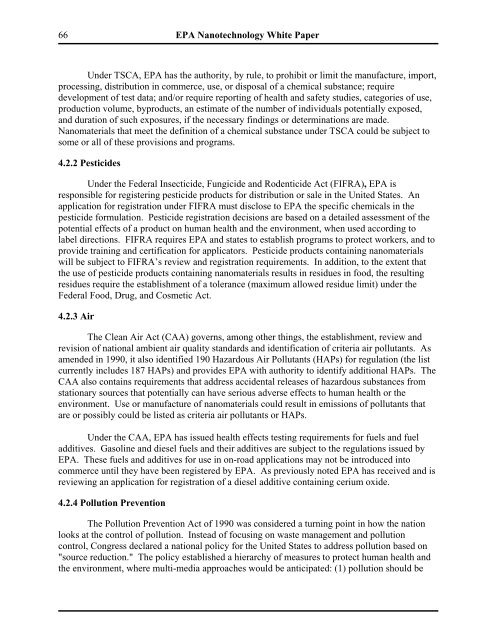Nanotechnology White Paper - US Environmental Protection Agency
Nanotechnology White Paper - US Environmental Protection Agency
Nanotechnology White Paper - US Environmental Protection Agency
You also want an ePaper? Increase the reach of your titles
YUMPU automatically turns print PDFs into web optimized ePapers that Google loves.
66 EPA <strong>Nanotechnology</strong> <strong>White</strong> <strong>Paper</strong><br />
Under TSCA, EPA has the authority, by rule, to prohibit or limit the manufacture, import,<br />
processing, distribution in commerce, use, or disposal of a chemical substance; require<br />
development of test data; and/or require reporting of health and safety studies, categories of use,<br />
production volume, byproducts, an estimate of the number of individuals potentially exposed,<br />
and duration of such exposures, if the necessary findings or determinations are made.<br />
Nanomaterials that meet the definition of a chemical substance under TSCA could be subject to<br />
some or all of these provisions and programs.<br />
4.2.2 Pesticides<br />
Under the Federal Insecticide, Fungicide and Rodenticide Act (FIFRA), EPA is<br />
responsible for registering pesticide products for distribution or sale in the United States. An<br />
application for registration under FIFRA must disclose to EPA the specific chemicals in the<br />
pesticide formulation. Pesticide registration decisions are based on a detailed assessment of the<br />
potential effects of a product on human health and the environment, when used according to<br />
label directions. FIFRA requires EPA and states to establish programs to protect workers, and to<br />
provide training and certification for applicators. Pesticide products containing nanomaterials<br />
will be subject to FIFRA’s review and registration requirements. In addition, to the extent that<br />
the use of pesticide products containing nanomaterials results in residues in food, the resulting<br />
residues require the establishment of a tolerance (maximum allowed residue limit) under the<br />
Federal Food, Drug, and Cosmetic Act.<br />
4.2.3 Air<br />
The Clean Air Act (CAA) governs, among other things, the establishment, review and<br />
revision of national ambient air quality standards and identification of criteria air pollutants. As<br />
amended in 1990, it also identified 190 Hazardous Air Pollutants (HAPs) for regulation (the list<br />
currently includes 187 HAPs) and provides EPA with authority to identify additional HAPs. The<br />
CAA also contains requirements that address accidental releases of hazardous substances from<br />
stationary sources that potentially can have serious adverse effects to human health or the<br />
environment. Use or manufacture of nanomaterials could result in emissions of pollutants that<br />
are or possibly could be listed as criteria air pollutants or HAPs.<br />
Under the CAA, EPA has issued health effects testing requirements for fuels and fuel<br />
additives. Gasoline and diesel fuels and their additives are subject to the regulations issued by<br />
EPA. These fuels and additives for use in on-road applications may not be introduced into<br />
commerce until they have been registered by EPA. As previously noted EPA has received and is<br />
reviewing an application for registration of a diesel additive containing cerium oxide.<br />
4.2.4 Pollution Prevention<br />
The Pollution Prevention Act of 1990 was considered a turning point in how the nation<br />
looks at the control of pollution. Instead of focusing on waste management and pollution<br />
control, Congress declared a national policy for the United States to address pollution based on<br />
"source reduction." The policy established a hierarchy of measures to protect human health and<br />
the environment, where multi-media approaches would be anticipated: (1) pollution should be

















